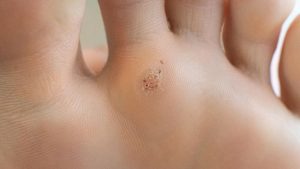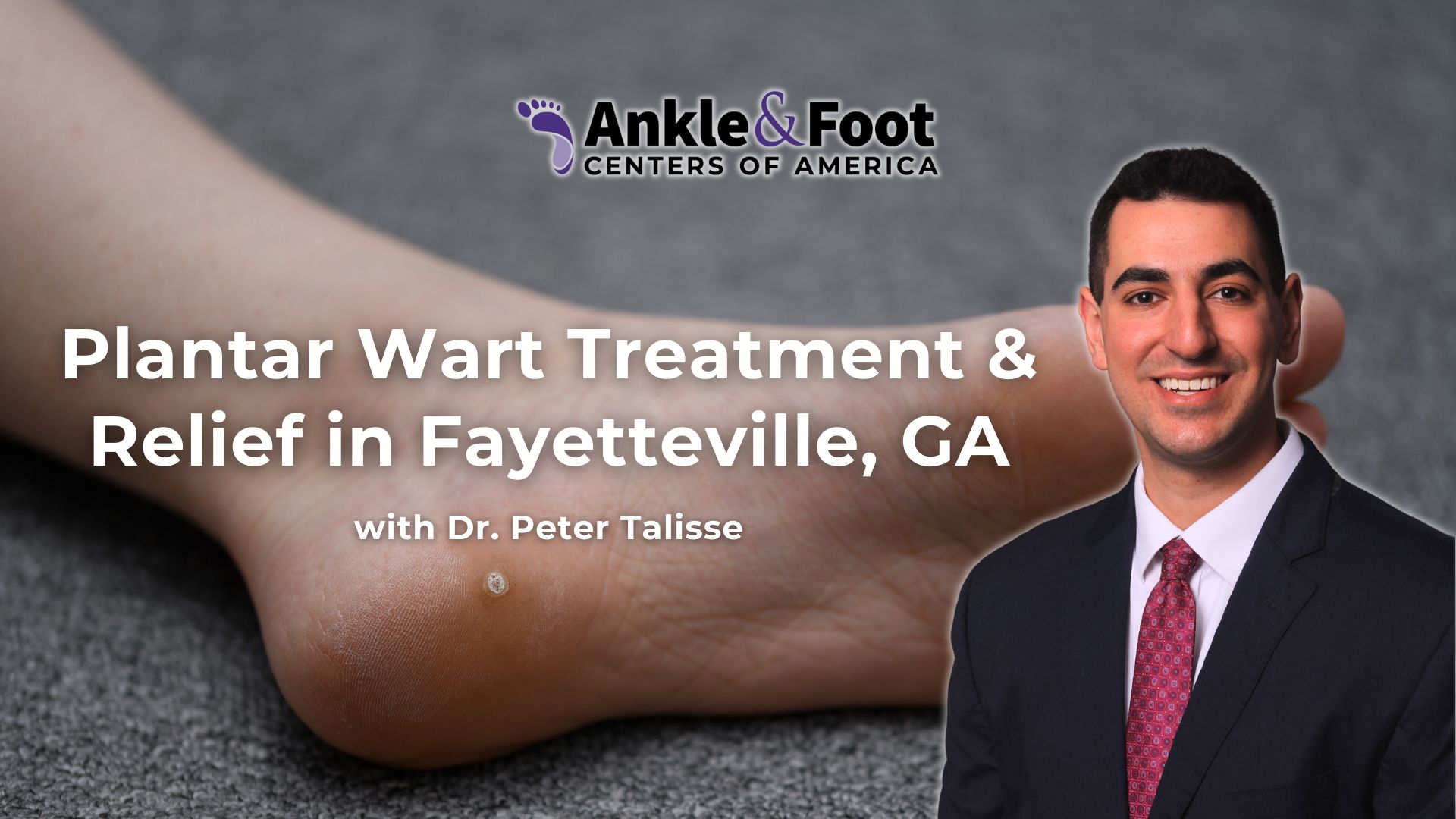Plantar warts can make every step uncomfortable — from standing at work to walking around the house. These small growths often appear on the bottom of the foot and are caused by a common virus that thrives in warm, moist environments. Fortunately, plantar wart treatment in Fayetteville, Georgia is available to help relieve pain and restore comfort quickly.
At the Ankle & Foot Centers of America, patients receive advanced care for plantar warts, combining precise diagnosis with effective treatment options to ensure lasting relief.
A plantar wart develops when the human papillomavirus (HPV) enters through tiny breaks or weak spots in the skin. Unlike common warts that grow outward, plantar warts are pushed inward due to the constant pressure from walking or standing. They often appear on the heel, ball of the foot, or beneath the toes and may look like thick, rough patches of skin with small black dots — clotted blood vessels sometimes called “wart seeds.” While they are not dangerous, plantar warts can cause sharp pain and make daily movement difficult if ignored.
Table of Contents
Why Plantar Warts Occur
HPV thrives in warm, moist environments. It spreads easily through direct contact or by touching contaminated surfaces. Locker rooms, gym showers, and pool decks are common places where the virus can spread.
Certain factors increase the risk of developing plantar warts:
- Walking barefoot in public areas
- Cuts, cracks, or soft spots on the skin
- Excess moisture or sweating in shoes
- A weakened immune system
Because plantar warts are contagious, it’s easy to pick up the virus from shared floors, towels, or footwear. Simple habits, such as keeping feet clean, dry, and protected in public spaces, greatly reduce the risk of infection.

Plantar Wart vs. Callus: How to Recognize the Difference
A plantar wart can sometimes be mistaken for a callus or corn. Knowing what to look for helps with early detection and faster relief.
Common signs include: 
- Rough, grainy skin on the bottom of the foot
- Tiny black dots within the growth
- Pain or tenderness when walking or standing
- Skin ridges that stop at the edge of the lesion
- Discomfort when squeezing the sides of the growth
If the pain begins to interfere with walking, or if new lesions appear, it’s time to have it evaluated.
How to Treat a Plantar Wart
At the Ankle & Foot Centers of America in Fayetteville, treatment focuses on comfort, precision, and prevention. Under the care of Dr. Peter Talisse, patients receive a customized plan designed to remove the wart safely and restore healthy skin.
Conservative Care
For mild or early cases, the goal is to remove infected tissue while protecting surrounding skin. Common methods include:
- Prescription topical treatments that gradually exfoliate the wart.
- Debridement to clear away thick, dead skin layers that trap the virus.
- Padding or inserts to reduce pressure on the area and relieve pain.
- Hygiene and shoe recommendations to prevent further irritation.
In-Office Procedures
If a wart doesn’t respond to conservative care, Dr. Talisse may recommend one of several effective in-office treatments: 
- Cryotherapy: Controlled freezing destroys wart tissue and triggers new, healthy skin growth.
- Laser therapy: Focused energy cuts off blood supply to the wart, helping it fall away naturally.
- Surgical removal: For deep or resistant lesions, a minor procedure under local anesthesia can remove the growth entirely.
Each approach is chosen carefully based on the wart’s size, depth, and location.
Preventive & Follow-Up Strategies
Even after successful treatment, prevention remains key. Steps include:
- Keeping feet dry and clean throughout the day
- Wearing shower shoes or sandals in public areas
- Changing socks daily and rotating shoes to reduce moisture
- Avoiding shared footwear or towels
- Returning for follow-up visits to ensure full healing and prevent recurrence
Why Professional Care Matters
Plantar warts can be stubborn and misleading. What looks like a wart might actually be a corn, a callus, or another type of lesion. Accurate diagnosis leads to faster, safer results.
Professional care also provides:
- Faster recovery: Office treatments reach deeper layers that home remedies often miss.
- Reduced discomfort: Techniques minimize pain and pressure while healing.
- Prevention of recurrence: Complete eradication of the virus lowers the chance of return.
- Safer care for special conditions: Patients with diabetes or circulation problems benefit from medical supervision that prevents complications.
Choosing professional podiatric care ensures that every step toward recovery is safe and effective.
Step-by-Step Care for Plantar Wart Treatment
Patients visiting the Fayetteville office can expect a smooth, thorough process designed around their comfort and needs:
- Review of medical history and prior treatments
- Examination of the affected area to confirm diagnosis
- Discussion of treatment options suited to lifestyle and activity level
- Creation of a personalized care plan with clear expectations
- Guidance on footwear and pressure relief during healing
- Scheduled follow-ups to monitor progress and prevent recurrence
The overall goal is simple — remove the wart, relieve discomfort, and restore confidence when walking.
Frequently Asked Questions
Are plantar warts contagious?
Yes. They can spread through direct contact or by touching shared surfaces like locker room floors, pool decks, or shower tiles.
Can over-the-counter treatments work?
They may help in mild cases, but most plantar warts require stronger medical treatment for complete removal.
Why do plantar warts return?
The virus can remain in the skin even after visible signs disappear. Preventive care and follow-up visits help reduce recurrence.
When should someone see a podiatrist?
If the wart becomes painful, changes in appearance, or begins spreading, a podiatrist should evaluate it promptly.
How can plantar warts be prevented?
Keep feet clean and dry, wear shoes in public areas, and avoid sharing socks or shoes. Routine foot checks also help detect early changes.
Take the Next Step Toward Comfort
A plantar wart may start as a minor irritation but can quickly turn into a painful problem if ignored. The good news is that effective treatment is available. At the Ankle & Foot Centers of America in Fayetteville, Dr. Peter Talisse combines advanced methods with personalized care to help patients walk comfortably again.
If you notice a painful spot on the bottom of your foot or think you might have a wart, don’t wait for it to worsen. Call our Fayetteville office at 678-831-9272 to schedule an appointment with Dr. Peter Talisse, or book your visit online for convenient access to expert care. Take the first step toward lasting comfort and healthy, wart-free feet today.






